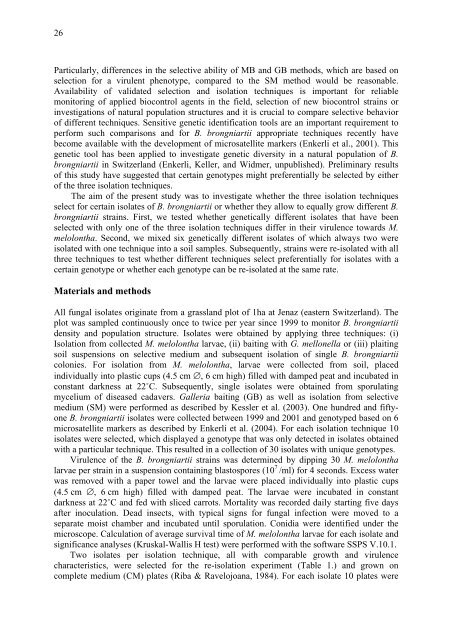IOBC/wprs Bulletin Vol. 28(2) 2005
IOBC/wprs Bulletin Vol. 28(2) 2005
IOBC/wprs Bulletin Vol. 28(2) 2005
Create successful ePaper yourself
Turn your PDF publications into a flip-book with our unique Google optimized e-Paper software.
26<br />
Particularly, differences in the selective ability of MB and GB methods, which are based on<br />
selection for a virulent phenotype, compared to the SM method would be reasonable.<br />
Availability of validated selection and isolation techniques is important for reliable<br />
monitoring of applied biocontrol agents in the field, selection of new biocontrol strains or<br />
investigations of natural population structures and it is crucial to compare selective behavior<br />
of different techniques. Sensitive genetic identification tools are an important requirement to<br />
perform such comparisons and for B. brongniartii appropriate techniques recently have<br />
become available with the development of microsatellite markers (Enkerli et al., 2001). This<br />
genetic tool has been applied to investigate genetic diversity in a natural population of B.<br />
brongniartii in Switzerland (Enkerli, Keller, and Widmer, unpublished). Preliminary results<br />
of this study have suggested that certain genotypes might preferentially be selected by either<br />
of the three isolation techniques.<br />
The aim of the present study was to investigate whether the three isolation techniques<br />
select for certain isolates of B. brongniartii or whether they allow to equally grow different B.<br />
brongniartii strains. First, we tested whether genetically different isolates that have been<br />
selected with only one of the three isolation techniques differ in their virulence towards M.<br />
melolontha. Second, we mixed six genetically different isolates of which always two were<br />
isolated with one technique into a soil samples. Subsequently, strains were re-isolated with all<br />
three techniques to test whether different techniques select preferentially for isolates with a<br />
certain genotype or whether each genotype can be re-isolated at the same rate.<br />
Materials and methods<br />
All fungal isolates originate from a grassland plot of 1ha at Jenaz (eastern Switzerland). The<br />
plot was sampled continuously once to twice per year since 1999 to monitor B. brongniartii<br />
density and population structure. Isolates were obtained by applying three techniques: (i)<br />
Isolation from collected M. melolontha larvae, (ii) baiting with G. mellonella or (iii) plaiting<br />
soil suspensions on selective medium and subsequent isolation of single B. brongniartii<br />
colonies. For isolation from M. melolontha, larvae were collected from soil, placed<br />
individually into plastic cups (4.5 cm ∅, 6 cm high) filled with damped peat and incubated in<br />
constant darkness at 22˚C. Subsequently, single isolates were obtained from sporulating<br />
mycelium of diseased cadavers. Galleria baiting (GB) as well as isolation from selective<br />
medium (SM) were performed as described by Kessler et al. (2003). One hundred and fiftyone<br />
B. brongniartii isolates were collected between 1999 and 2001 and genotyped based on 6<br />
microsatellite markers as described by Enkerli et al. (2004). For each isolation technique 10<br />
isolates were selected, which displayed a genotype that was only detected in isolates obtained<br />
with a particular technique. This resulted in a collection of 30 isolates with unique genotypes.<br />
Virulence of the B. brongniartii strains was determined by dipping 30 M. melolontha<br />
larvae per strain in a suspension containing blastospores (10 7 /ml) for 4 seconds. Excess water<br />
was removed with a paper towel and the larvae were placed individually into plastic cups<br />
(4.5 cm ∅, 6 cm high) filled with damped peat. The larvae were incubated in constant<br />
darkness at 22˚C and fed with sliced carrots. Mortality was recorded daily starting five days<br />
after inoculation. Dead insects, with typical signs for fungal infection were moved to a<br />
separate moist chamber and incubated until sporulation. Conidia were identified under the<br />
microscope. Calculation of average survival time of M. melolontha larvae for each isolate and<br />
significance analyses (Kruskal-Wallis H test) were performed with the software SSPS V.10.1.<br />
Two isolates per isolation technique, all with comparable growth and virulence<br />
characteristics, were selected for the re-isolation experiment (Table 1.) and grown on<br />
complete medium (CM) plates (Riba & Ravelojoana, 1984). For each isolate 10 plates were

















